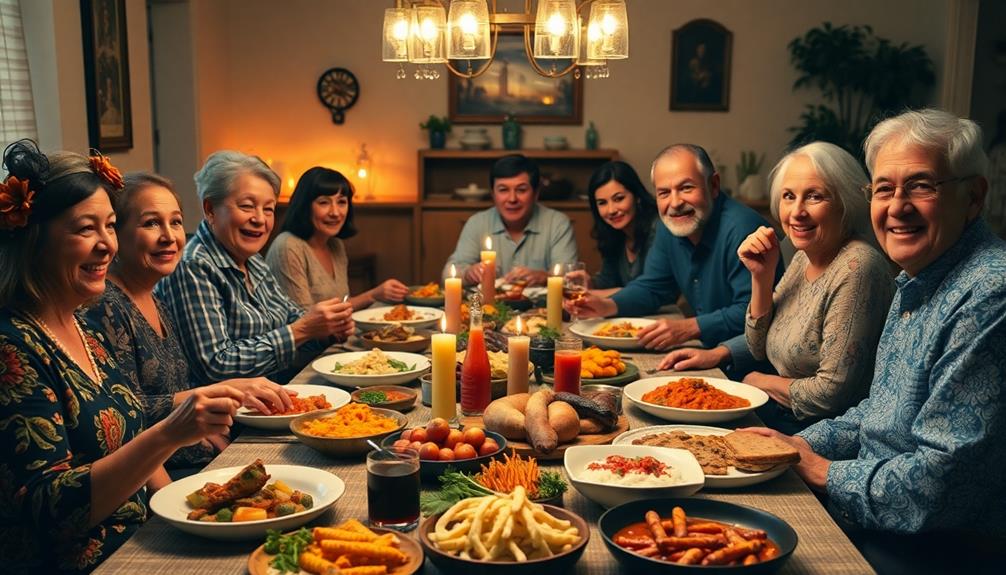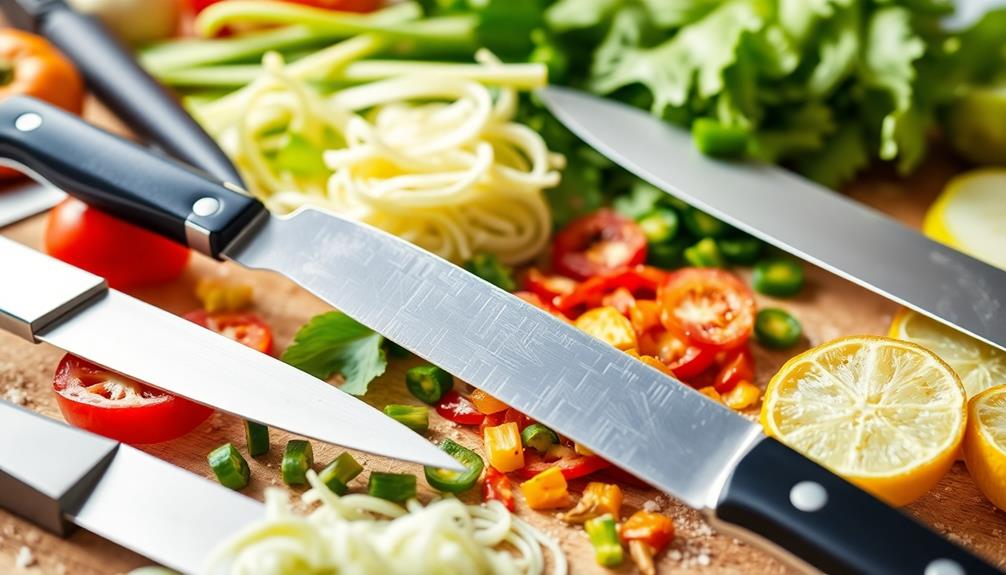Food nostalgia in expatriates taps into the neuroscience of memory. When you encounter familiar dishes, their aromas trigger your hippocampus, releasing vivid recollections of home. This occurs because certain scents evoke powerful emotions and feelings of safety. Your brain also links comforting flavors to joyful moments, enhancing feelings of connection and belonging. As you savor traditional meals, you're not just eating; you're preserving cultural identity and shared experiences. The impact of these culinary experiences on your emotional landscape is profound. Want to uncover more about how these flavors influence your nostalgia and identity?
Key Takeaways
- Expatriates experience nostalgia through familiar food aromas, which activate the hippocampus, linking memories to specific culinary scents.
- Sweet foods trigger dopamine release, enhancing joyful memories and alleviating feelings of homesickness for expatriates.
- Shared meals strengthen social bonds, fostering intergenerational memories and cultural identity among expatriates.
- The Proust phenomenon demonstrates how traditional dishes evoke vivid memories, providing emotional comfort in foreign environments.
- Culinary experiences connect expatriates to their roots, helping preserve cultural identity through olfactory and gustatory cues.
The Role of Food in Memory

Everyone has experienced the way a certain dish can transport you back in time. Food and memory are intricately linked, with specific smells triggering vivid recollections before you even realize it. For instance, the aroma of bulgogi (marinated beef) can instantly evoke memories of family gatherings or festive celebrations.
Your olfactory senses play an essential role here; they access memories stored in the hippocampus, making certain meals unforgettable. When you smell a familiar aroma, it can evoke positive emotions, bringing a rush of nostalgia that connects you to past experiences.
Hormones released during digestion enhance these memories, reinforcing the connection between food and autobiographical memories. Sweet treats, in particular, activate your brain's reward centers, releasing dopamine that solidifies those joyful moments in your mind.
You might find that the novelty of a new dish makes it even more memorable, as emotional experiences tied to food are enriched by unique flavors and settings.
Every meal you enjoy can become a thread in your tapestry of memories, weaving together moments of joy, comfort, and connection.
Evolutionary Perspectives on Taste

Our taste preferences have deep evolutionary roots that shape how we experience food and memory. Evolutionary perspectives highlight how your brain prioritizes food-related memories, especially those tied to sweetness. This preference stems from our fruit-seeking ancestors, where sweet foods signaled energy-rich sustenance essential for survival.
For instance, many cherished dishes, like Agnolotti, often evoke nostalgia through their comforting flavors and textures. When you indulge in something sweet, it triggers reward centers in your brain, releasing dopamine and reinforcing the memory of that pleasurable experience.
The hippocampus plays a significant role in encoding these food-related memories, often enhanced by olfactory connections. The aroma of your favorite dish can transport you back to cherished moments, elevating your sensory experience.
This interplay between taste and memory not only aids in individual survival but also fosters social bonds. Shared meals create lasting memories that connect generations.
Understanding these evolutionary mechanisms helps you appreciate the pleasure of eating. It's not just about nourishment; it's about the emotional and social layers that food brings into your life.
As you savor familiar flavors, you're tapping into a rich history shaped by survival, pleasure, and connection, making each bite a reminder of where you've come from.
Cultural Significance and Identity

Food often serves as a bridge to one's cultural identity, evoking powerful memories that connect expatriates to their homeland. When you savor familiar dishes, like kimchi for Koreans or ghee for Indians, you experience nostalgia that transcends time and distance. These ingredients act as transitional objects, providing emotional comfort and maintaining a sense of belonging in unfamiliar environments.
For instance, enjoying a comforting plate of Mushroom Masala can awaken cherished memories of family gatherings and celebrations. The cultural practices surrounding food, such as communal feasting, strengthen your ties to identity and enhance collective memory within diaspora communities. Each bite of traditional food isn't just about taste; it's a sensory experience that evokes strong emotional responses, allowing you to reconnect with your roots.
The olfactory and gustatory features of your favorite meals create vivid memories, serving as reminders of home. In the diaspora, food becomes a vital element in preserving cultural identity. It fosters connections to heritage and creates a shared experience among expatriates.
Sensory Triggers of Nostalgia

Amid the myriad ways nostalgia can manifest, sensory triggers, particularly through taste and smell, often hold the most profound influence. The olfactory system is remarkably potent, with studies revealing that 54% of odor trials evoke nostalgia, while only 26% of music triggers similar feelings.
As an expatriate, you might find that familiar scents and flavors linked to traditional dishes evoke powerful emotional responses, transporting you back to cherished moments. This aligns with the "Proust phenomenon," where specific foods can spark vivid memories through taste and smell.
When you encounter the aromas of nostalgic dishes in unfamiliar environments, these sensory experiences can create feelings of safety and comfort. Research shows that nostalgic foods are rated notably higher in emotional relevance, enhancing your connection to your cultural identity and past experiences.
As you savor these flavors, they not only remind you of home but also help bridge the gap between your present and your roots. The interplay of olfactory and taste sensations effectively anchors you in cherished memories, making the experience of nostalgia a deeply emotional journey for expatriates maneuvering their new surroundings.
Food's Impact on Expat Experiences

Culinary experiences greatly shape expatriates' emotional landscapes, providing an essential link to their cultural roots. When you find yourself missing home, food often becomes a comforting refuge. The familiar tastes and aromas of your native cuisine can alleviate feelings of nostalgia and homesickness, enhancing your emotional well-being.
Seeking out specific ingredients or recreating beloved dishes allows you to maintain a connection to your cultural identity, even in unfamiliar environments.
The olfactory and gustatory cues associated with traditional foods evoke powerful memories, transporting you back to cherished moments. These sensory experiences act as transitional objects, offering stability as you navigate new cultural landscapes.
You might recall family gatherings or festive celebrations, recalling the laughter and warmth that surrounded those meals.
Social media has also transformed how expatriates celebrate their culinary traditions. Sharing recipes and experiences online fosters a sense of community, allowing you to connect with fellow expatriates who understand your longing for home.
This sense of belonging is crucial for preserving your cultural identity, reminding you that while you may be far from home, the flavors of your heritage are always within reach.
Frequently Asked Questions
What Is the Neuroscience Behind Nostalgia?
Nostalgia activates brain areas tied to emotion and memory. When you recall past experiences, your brain releases neurotransmitters, creating positive feelings. This emotional connection enhances your sense of identity and can buffer against loneliness.
What Is the Science Behind Food Nostalgia?
Food nostalgia's science lies in how smells trigger vivid memories, activating your limbic system. This connection enhances positive emotions, boosts self-esteem, and fosters social bonds, making nostalgic foods more emotionally impactful than other sensory experiences.
What Is It Called When Food Brings Back Memories?
Food's like a time machine; it whisks you back to cherished moments. When food brings back memories, it's called "food-evoked nostalgia." Those familiar flavors can rekindle emotions, connecting you to your past in profound ways.
When It Comes to Food, What Comes to Mind as Nostalgic?
When you think of nostalgic food, memories of your childhood favorites likely flood your mind. It could be your grandma's cookies, that comforting soup, or the candy you loved—each bite reminding you of cherished moments.
Conclusion
So, next time you find yourself reminiscing over a plate of home-cooked comfort, remember that your taste buds are just as much a time machine as they are a meal. It's ironic, isn't it? You may be thousands of miles from home, yet a single bite can transport you back, making you feel both closer to your roots and painfully aware of your distance. In the end, food nostalgia isn't just about the past; it's about the bittersweet present.









